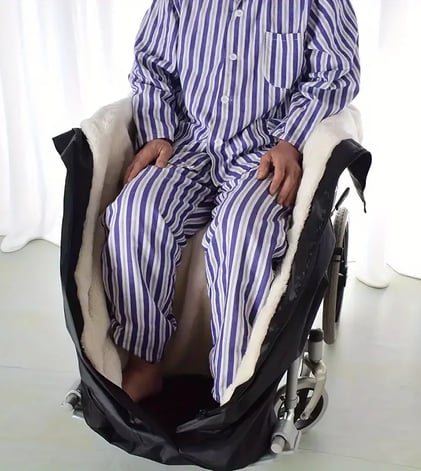Stay Warm While Exploring: Essential Tips for Wheelchair Users in Winter
10/31/20245 min read


The Importance of Staying Warm
For wheelchair users, maintaining warmth during winter outings is essential not only for comfort but also for overall health. Cold weather can expose individuals with limited mobility to increased risks, as their bodies may have a diminished capacity to regulate temperature effectively. This is particularly critical when seated for extended periods, which can limit circulation and exacerbate feelings of cold. Therefore, understanding the importance of staying warm should be a priority for those who rely on wheelchairs.
The human body functions optimally within a specific temperature range. When outdoor temperatures drop, the body's natural response is to conserve heat, which becomes increasingly challenging for individuals with reduced mobility. Sitting in a wheelchair can impair blood flow to the extremities, making hands and feet particularly susceptible to the cold. If left unaddressed, this increase in cold exposure may lead to discomfort, numbness, or in severe cases, frostbite. Thus, ensuring that adequate measures are in place to combat cold weather is paramount.
Moreover, there are various challenges wheelchair users encounter in winter, such as navigating icy or snowy terrain, which can deter enthusiasm for outdoor activities. However, it is important to remain vigilant about the importance of thermal comfort not only for physical well-being but also for mental health. Experiencing warmth can enhance mood and promote social engagement during the often isolating winter months. Therefore, the pursuit of effective ways to stay warm should be an integral part of planning any winter outing for wheelchair users.
Given these considerations, effective layering strategies, suitable thermal accessories, and pre-planning routes can mitigate the risks associated with cold weather exposure. Prioritizing warmth will not only enhance safety but also enrich the overall quality of outdoor experiences for wheelchair users during winter.
Choosing the Right Gear
When engaging in outdoor activities during winter, selecting the appropriate gear is crucial for wheelchair users to ensure warmth, comfort, and safety. The right clothing and accessories can significantly enhance the experience while exploring in cold conditions. First and foremost, investing in thermal layers is essential. These base layers should be made of materials that trap heat while effectively wicking moisture away from the body. Fabrics such as merino wool or synthetic blends are excellent choices, as they provide warmth without compromising breathability.
Next, a waterproof outer layer is fundamental in protecting against wind, rain, and snow. Windbreakers or insulated jackets with water-resistant properties not only maintain warmth but also keep moisture at bay. When selecting outerwear, look for options that allow for easy mobility and do not restrict movement, as wheelchair users may need additional flexibility. Pairing this with waterproof pants, which are designed to keep you dry while seated, can provide a comprehensive approach to battling winter weather.
Footwear is another essential aspect of winter gear. Insulated, waterproof boots will keep feet warm and dry, and should include non-slip soles for added safety on icy surfaces. Additionally, warmth can be further enhanced with thermal socks made from wool or advanced synthetic materials. Accessories like gloves, hats, and scarves are also vital to maintaining heat, as extremities often lose warmth quickly. Opt for gloves that provide dexterity yet enough insulation to keep fingers warm, and consider hats that cover the ears while still allowing for comfort against the back of the wheelchair.
By carefully choosing each piece of winter gear, wheelchair users can confidently explore and enjoy outdoor activities even in cold weather, ensuring a pleasant and safe experience.
Practical Tips for Enjoying Winter Outings
Winter outings can be a delightful experience, particularly when exploring festive events such as Christmas markets. However, accessibility and comfort are paramount for wheelchair users. To enhance the experience, careful planning is essential, beginning with the selection of outdoor locations. It is crucial to identify venues that are wheelchair accessible, ensuring that pathways are clear of snow and ice. This can prevent potential accidents and make the outing more enjoyable.
Planning ahead is also vital for restroom breaks during extended outings. Many public restrooms may be difficult to access during winter months due to snow accumulation and freezing temperatures. Thus, it's wise to locate accessible facilities in advance and reach out to event organizers if necessary to confirm accessibility details. This proactive approach allows for smoother navigation and reduces stress during your outing.
To minimize exposure to cold, several techniques can be leveraged to ensure comfort throughout the day. Using hand warmers, for instance, can provide much-needed warmth for hands, which are often exposed to cold air while maneuvering the wheelchair. Additionally, incorporating proper insulation for the wheelchair is essential. Using a quality warm waterproof blanket not only aids in retaining body heat but also protects against wind chill, covering the legs and lower body effectively.
Moreover, dressing in layers can significantly enhance comfort levels. Opt for thermal undergarments, insulated jackets, and layering pants to help retain warmth. Accessories like hats, gloves, and scarf are equally important, as they help trap heat and shield from the elements. Emphasizing such detail helps ensure a more enjoyable, and importantly safe, winter outing for wheelchair users.
Investing in a Cozy Warm Blanket
For wheelchair users, staying warm during winter outings is essential for comfort and overall well-being. A cozy warm waterproof blanket serves as an invaluable accessory for those who wish to explore outdoor winter activities. This versatile item not only provides insulation against the cold but also enhances ease of use and practicality, allowing users to enjoy their time outdoors.
When selecting the ideal blanket, several features must be considered to ensure maximum comfort and utility. First and foremost, the size of the blanket is crucial; it should be large enough to cover the user's legs and torso, providing adequate warmth without being cumbersome. A compact design can also facilitate easy storage and transportation, making it a perfect companion for outings.
Weight also plays a significant role when choosing a cosy warm blanket. Ideally, the blanket should be lightweight yet provide sufficient insulation, ensuring it does not add unnecessary bulk or weight to the wheelchair. This balance allows users to maintain mobility and comfort, particularly during long periods spent outdoors.
Waterproof capabilities are another essential feature. A cosy warm waterproof blanket can protect against moisture from snow or rain, ensuring that users remain dry as well as warm. This is particularly important when engaging in outdoor activities where exposure to the elements is unavoidable, such as snow sports or festive winter markets.
In summary, investing in a cozy warm waterproof blanket not only enhances the experience of wheelchair users during winter but also addresses critical aspects of comfort, practicality, and durability. For those looking to purchase such a blanket, reputable brands are readily available, offering a wide range of options tailored to individual needs. For instance, you may check out this [cozy blanket](https://temu.to/k/epjqvo3dvac) for quality assurance and customer satisfaction. Discovering the right product can greatly improve winter outings, empowering users to enjoy the season fully.




